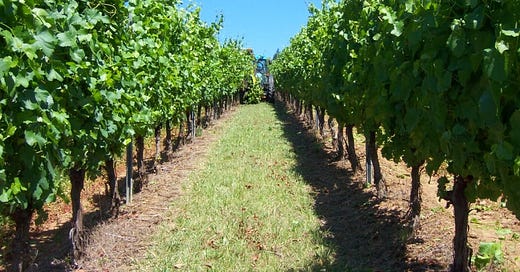Amalie Robert Estate Climate Update: 2013 July
Hello and Welcome,
This is the climate update for the month of July 2013.
July brings with it the busiest time in the vineyard. The vines are literally growing out of control despite our best efforts to position their shoots and clip them into the wires. It seems we are “all out there steppin’ and fetchin’ like our heads are on fire and our grasses are catchin’.” (A little inspiration from the Charles Daniels band there.)
But then there is the hedging. This machine is the vineyard’s great equalizer. The vines take up as much soil moisture as they can and use it to grow shoots and leaves. The more soil moisture they have, the more of this behavior they exhibit. This is where you can learn a lot just by looking around. The parts of the vineyard that are showing only moderate shoot growth are low on available soil moisture and more likely than not to ripen their fruit earlier than areas with more available soil moisture, ceteris paribus.

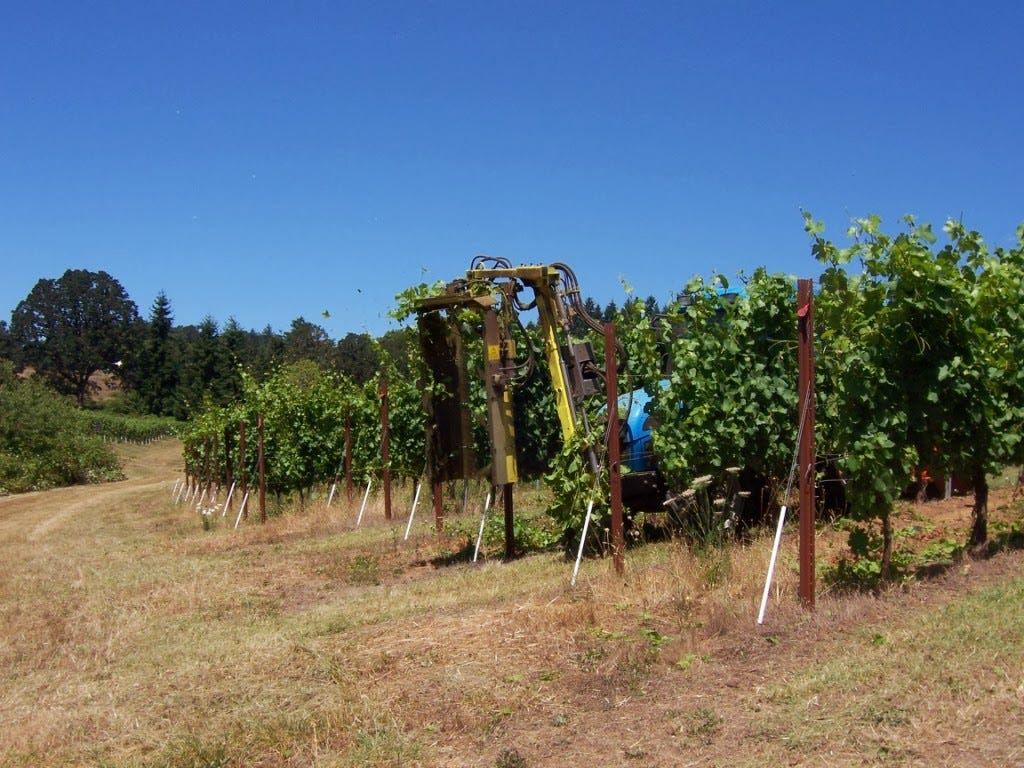
However things are never really what they seem, specious maybe, but certainly not ceteris paribus. The hedging, however, makes a good first cut at returning all of the shoot growth to an equal level. At Amalie Robert Estate, we like to see a 7 ½ foot tall canopy, because our rows are 7 ½ feet wide. This maximizes the potential sunlight absorption of the canopy. Really.

For about a week or so after the first hedging pass, it is pretty quiet out there. The vines seem to be shocked into submission. Hardly. What they are doing is preparing for a second offensive. Along each shoot that we have so gingerly tucked into the trellis, there are several lateral buds. Inside these buds lie the potential for a lateral shoot, aka the second offensive. However, these buds will only push and grow that lateral shoot if the growing tip is cut off by the hedger or otherwise removed (usually by some foraging deer, like this one.)
The laterals are useful in growing additional leaf surface area. Something we were very much encouraging in 2010 and 2011. We needed all the leaf surface we could get in those cold vintages. However, in a warmer year like we seem to be experiencing now, too much leaf surface can have less than positive results. One of those is building excess sugars and the other is transpiring what little soil moisture we have too quickly. This combination leads to high sugars before the aromas and flavors in the skins can catch up. As a side note, we go through this every year with Viognier. Such a troublemaker.

There are a couple of things we can do about this. The first is to check the crystal ball to learn what our rain pattern will be this year. The next best alternative is to set the hedger just a little bit lower than 7 ½ feet, but higher than the top of the posts, which are 6 feet – good to know. This will remove a little extra leaf surface and slow down the accumulation of sugar as well as preserving our precious soil moisture. Next, we put a really tight trim on the grass between the rows. Ernie set the flail mower and hedger on the same tractor so he does this in a single pass. What a guy!

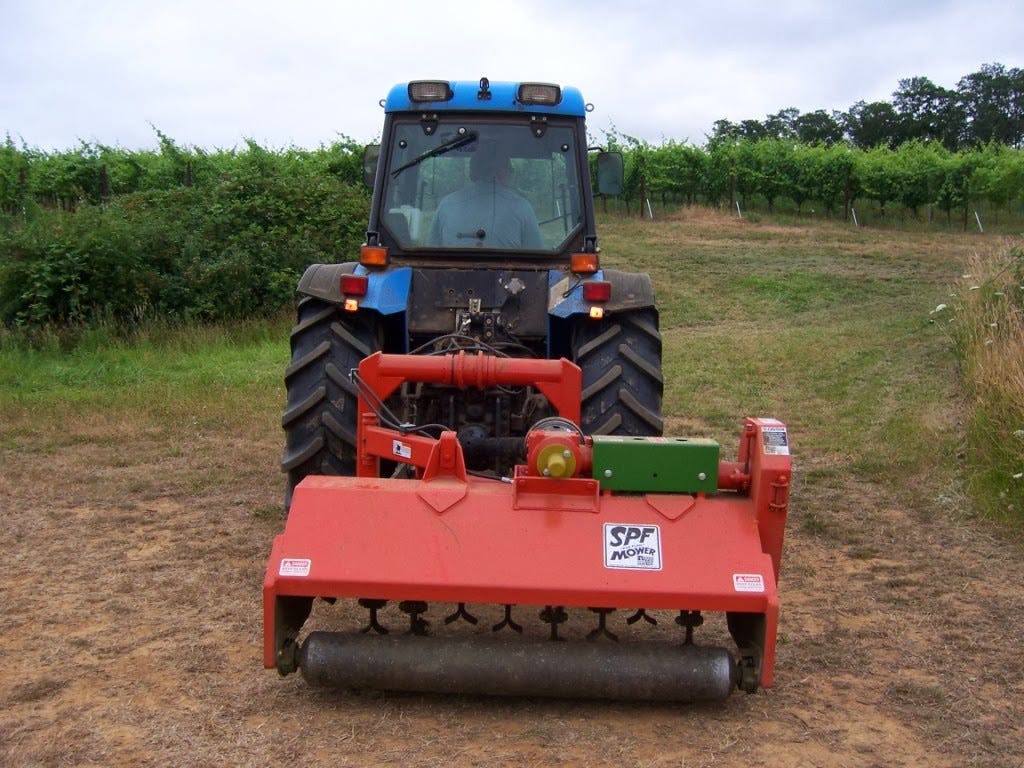
Check out the new flail mower – it swings both ways!
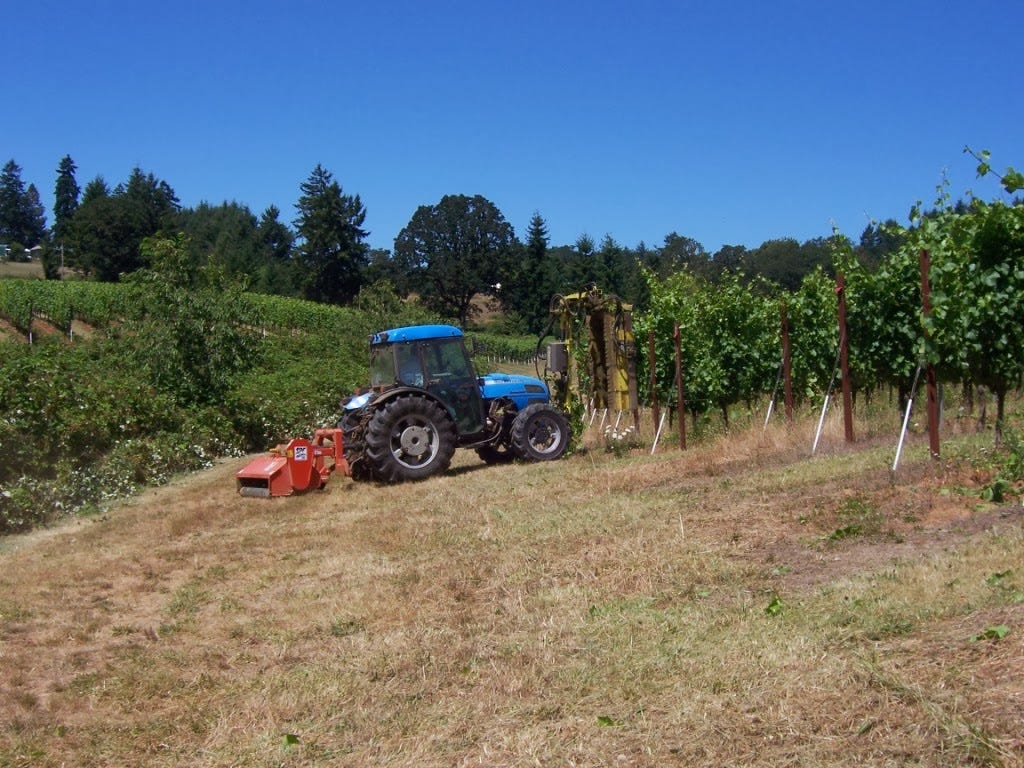
After all of this, we venture out into the great unknown – how much crop do we leave on the vine? Our crop load, or fruit set, is not heavy this year and here is the rub. The lower the yield per vine, the faster it will ripen. The faster it ripens, the less chance we have of really great aromas and flavors developing in the skins. Note that there are two kinds of ripening going on here. One is increasing sugars and decreasing acids. The other is flavor development in the skins. Both of these ripening curves depend on water.
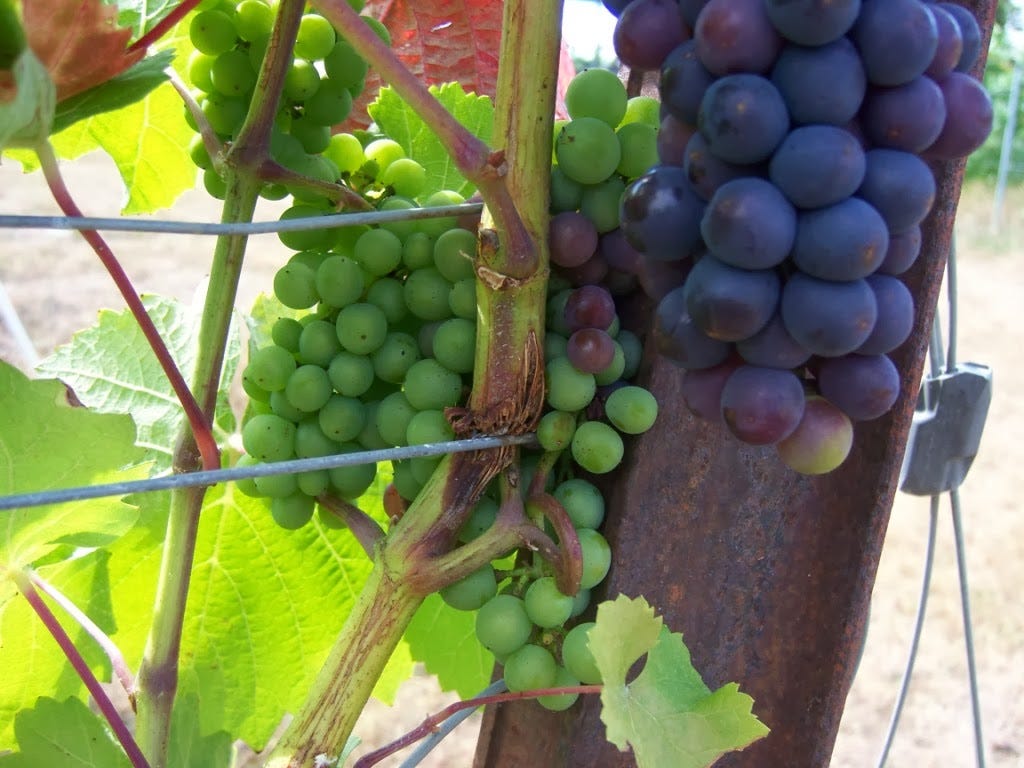
Let’s have a closer look at what is happening at the very top of row 66. The clusters on this vine are for the most part still green, except for the guy at the very end. Those berries are almost fully colored. How can this be? Water, or more accurately put - sap. Look closely and you will see the first catch wire is cutting into the shoot. Wires, like the IRS, are unyielding things and the shoot has no where to go. Don’t let this happen to you, have someplace to go, comrade.
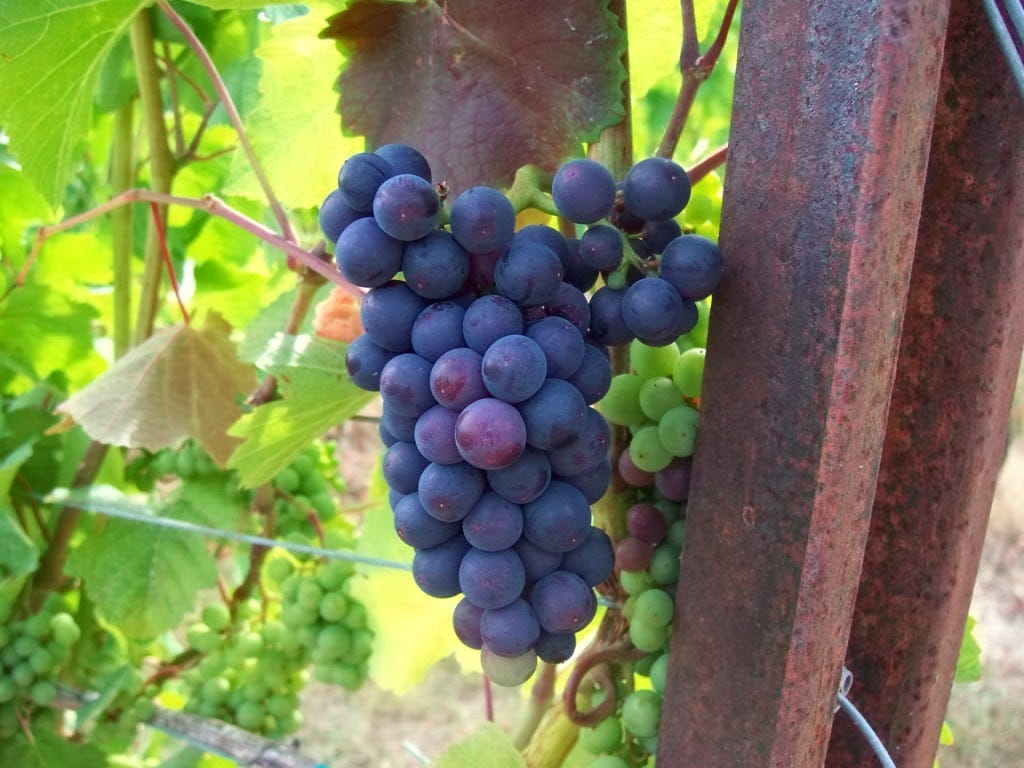
This has the effect of cutting off the sap to the shoot and specifically the cluster. The result is the berries getting the message, quite clearly, “RIPEN YOUR SEEDS NOW.” And in so doing, the cell walls of the skins and pulp around the seeds starts to break down. The berry uses its malic acid as an energy source which reduces the acid in the fruit. The dark berries are then spotted by a wandering animal and the seeds are deposited “way the Hell and gone” over the next hill. This is all well and good for the vine; they have seen this movie before. But from a wine quality point of view, we do not have the aroma flavor development yet.
What does this mean and why should I care? Ah yes. What we have just seen with this cluster will happen to the remaining clusters, but naturally. The vine will shut off the sap to each and every cluster, forcing the ripening process to begin. That is when things get interesting.
If we end up with warm breezes from the east, our berries desiccate and make raisins. So leaving a little extra crop will slow down the desiccation and accumulation of sugars and allow for more time on the vine. Another dynamic is in play here. If the vine cannot get water from the soil, it will dip into the clusters. So leaving a bit more fruit is really a hedge to slow down ripening, dilute sugars and increase aroma and flavor development.
If we get a weather pattern from the coast, it is going to rain. But the crystal ball was somewhat elusive in showing us exactly when and how much. Note here that sap and water are not the same things in the vine world. While the vine cuts the cluster off from the sap of the Phloem, it is still connected to the Xylem.
The Xylem, that’s where the water is. If we get rain, the berries on the cluster will absorb that water if the moisture makes it down to the root zone. If this happens, the berries can split and rot in situ. Not all is lost here, the seeds will still have ripened.
But a little moisture is what we are looking for as it also brings cooler temperatures to slow down ripening. A little shower here and there is usually taken up by the grassed rows and not really a big deal. Grasses are the most opportunistic of the plant world, they just wait like crocs at the watering hole. It’s as if they know it will rain. Maybe we should go chat them up…
Either way, the wings are coming off. The wing is the back up plan in case the main cluster does not set much fruit to ripen seeds. It is the back up plan because it sets fruit a week after the main cluster and therefore ripens a week later than the main cluster. We would rather leave a few more clusters and take the wings off, than just take a few clusters off and leave the rest of the clusters with their wings. Call us crazy but, it seems to be working…
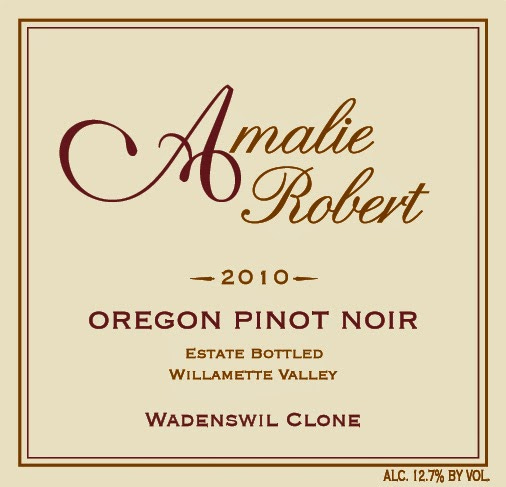
Amalie Robert Estate 2010 Wadenswil Clone Pinot Noir earns 93 points from the IWC!
“Bright red. High-pitched cherry and Asian spice aromas are deepened by notes of sassafras, woodsmoke and cola. Stains the palate with sappy red and dark berry flavors and tangy acidity adding lift and cut. An exotic floral nuance emerges with air and carries through a long, sweet and persistent finish. While this energetic pinot is built to age, it has a lot of immediate appeal. 93 points.”
- Stephen Tanzer's International Wine Cellar, July/Aug 2013
Tasting Notes and 2010 Harvest AAR
For those of you who trusted your palate and purchased this wine as futures, well done! Please note we have very limited availability at the winery. Please Email Dena to place your order while we retool our fulfillment solution.

As for our late release 2009 iPinot, there were also some very nice things to be said.
“Vivid ruby-red. Sexy, spice- and floral-accented aromas of raspberry and cherry-cola, with a smoky topnote. Offers sappy red fruit and floral pastille flavors and notes of gingerbread and white pepper. Shows a silken character, with real back-end energy. Weightier on the gently tannic finish, which strongly echoes the raspberry and floral notes. 92 points.”
- Stephen Tanzer's International Wine Cellar, July/Aug 2013
Tasting Notes and 2009 Harvest AAR
This wine is in good supply and is providing great pleasure now $38 by the bottle and $34 on 6. It gets better if you’re on the A-List. What’s the deal with the A-list?
Well who knew? The lady likes to go fast! It seems Mother Nature has hit top gear and is just rolling that power on! Looking good, sunshine!
We now present the July 2013 numbers from Amalie Robert Estate:
The month of July accumulated a very enjoyable 543.5 degree days, had a high of 92.7 (recorded July 2 at 2:40 pm) and a low of 45.0 (recorded July 22 at 5:40 am) with no farming rain at all. This brings the 2013 growing season up to 1,212.9 degree days from April 1 through July 31. Rainfall for the growing season remains at 6.24 inches.

The race is far from over, as we have heat accumulations for August and September yet to log (and rain, yes we will have rain.) These two months combined are typically in the 600 to 900 degree day range, except when they are not. To wit:
For those of you getting the first taste of the 2010 and 2011 vintages, please bear in mind each of those very cool vintages logged less than 1,800 degree days. Combine that low heat accumulation with an extended ripening window providing hang time into November and you have a couple of vintages for the record books. And many folks thought the 2007 vintage was “special.”
Here is what July 2012 looked like:
We have recorded about 449 degree days for the month of July, providing a total of 929 degree days since the beginning of the growing season on April 1st. This compares with 381 degree days last July and a comparative total of 689 degree days for 2011. During July, our highest high was 90.9 and our lowest low was 43.9 degrees Fahrenheit.
We received no measurable precipitation for the month of July. July 2011 brought the gift of 1.02 inches of rain. Rainfall from April 1st through July 31st was 8.96, and is 0.40 inches less than last year's growing season to date rainfall of 9.39 inches. Timing is everything.
The trend seems to be warmer and drier than last year. Hard to believe it could be wetter and colder, though as we now know, anything is possible. Mother Nature, while not very reliable, is somewhat predictable, and seems to be turning on her charm
Kindest Regards,
Dena & Ernie

